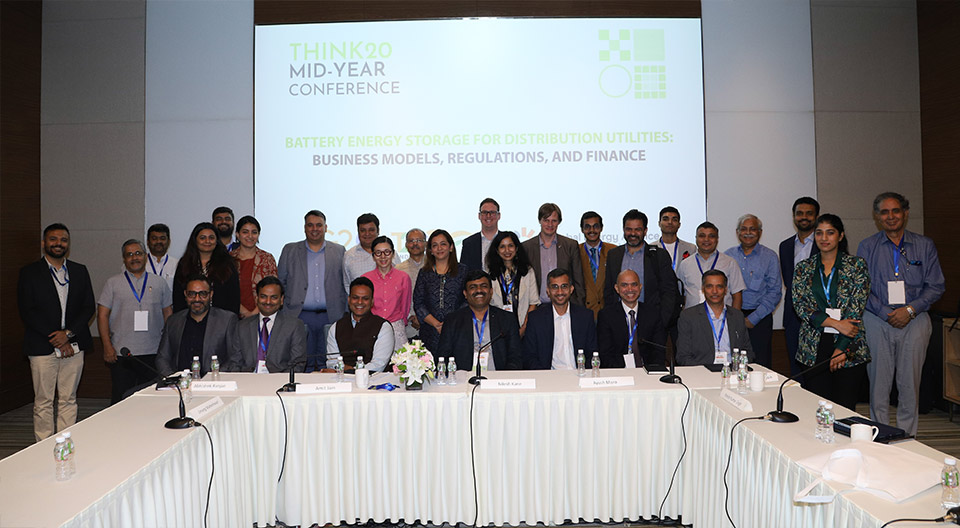Battery Energy Storage Systems for distribution utilities: Business models, regulations, and financing
The increasing demand for reliable and steady electricity from renewable sources has made battery energy storage systems (BESS) crucial for ensuring energy security. As India aims to enhance its
renewable energy penetration, the integration of substantial BESS across the electricity generation and delivery infrastructure becomes imperative to provide firm power and ensure grid stability. Recognising this need, the T20 Mid-Year Conference ide event, led by the Global Alliance for People and the Planet (GEAPP), explored the role of regulatory reforms, policy incentives, digital solutions, and the involvement of private sector and multilateral development banks in driving the adoption of BESS among distribution companies in India.
In his keynote address, Dr Sushanta Chatterjee, Chief of Regulatory Affairs and Power Market at the Central Electricity Regulatory Commission (CERC), emphasised the importance of flexible energy storage systems in managing the dynamic nature of renewable energy sources. Dr Chatterjee highlighted the viability of BESS due to its shorter gestation period, installation feasibility, and high ramping capability. Energy storage systems can store excess energy during periods of high generation and release it during peak demand, ensuring a reliable and balanced energy supply. He also emphasised the need for dynamic and efficient resources to minimise area control errors and maintain grid stability.
The panel of expert discussants also provided valuable insights into various aspects of integrating BESS with distribution utilities. Market and regulatory incentives play a vital role in supporting BESS integration, and establishing clear guidelines for grid connection, operation, and market participation are essential, pointed out Mr Abhishek Ranjan, Sr. VP Strategy & Head, Utilities & Retail, ReNew Power. He emphasised the importance of regulatory clarity and defined frameworks including guidelines for procurement of energy-based storage, clarifications by the Ministry of Power (MoP) regarding the role of energy storage systems (ESS) under the Electricity Act, and the introduction of ancillary service regulations. Mr Ranjan also highlighted the value of compensation mechanisms such as time-of-use tariff regimes to encourage demand response and load shifting. He further stressed the need for unified terms and integrated systems for the effective management of energy resources and called for demonstration projects and pilot initiatives at the distribution grid level to showcase the value and sustainability of storage integration.
The panellists also discussed the role of innovative business models and financing mechanisms for energy storage. To attract investments and financing, it is important to demonstrate the long-term profitability and reliability of energy storage projects, argues Ayush Misra, CEO, Ampere Hour. To this end, there is an increasing need to de-risk capital investment to prove the viability of BESS as a distribution asset. It was suggested that storage energy costs should not be compared with base load coal costs and instead account for a more comprehensive evaluation of capacity
costs and blended tariffs such that the true value and competitiveness of storage is recognized.
Additionally, Amit Jain, Senior Energy Specialist at the World Bank, highlighted the role of blended financing and viability gap funding (VGF) to reduce costs for end consumers. He further suggested that classifying storage as a green investment can act as a facilitating mechanism to unlock large pools of capital, including from government financing sources such as the National Clean Energy Fund and the Green Energy Corridor.
The current monetisable use cases for energy storage systems are primarily limited to peak shifting and energy arbitrage which capitalise on price differentials by storing excess energy during low-demand periods and supplying it during peak hours. However, to fully realize the potential of energy storage and unlock additional revenue streams, regulations are essential to encourage the monetisation of ancillary services provided by energy storage. There was a broad consensus among the panellists on this matter. Distributed renewable energy (DRE) sources and electric vehicles (EVs) were highlighted as examples in this context. Mr Jain further stated that establishing supportive regulatory frameworks that recognise the value of ancillary services and create mechanisms for compensation is vital to incentivise and spur the desired investments in the sector.
Participants also discussed the possibility of leveraging quantum technology for breakthroughs in energy storage. The potential application of quantum technology in simulating molecules and discovering new materials for supercapacitors or more cost-effective energy storage solutions was highlighted.
The event provided a platform for experts to discuss critical aspects of energy storage, including resource adequacy, value analysis frameworks, global perspectives, and business models. The discussions underscored the significance of understanding demand patterns, addressing financing challenges, identifying monetizable use cases, establishing supportive regulatory frameworks, developing innovative financing mechanisms, and achieving cost reductions for energy storage technologies. Participants recognised the need to address these issues to accelerate the adoption of energy storage and support India’s sustainable development goals. The event concluded with a call for collaboration among stakeholders to develop recommendations that can shape policies and regulations, facilitating the growth of the energy storage sector.
This event report has been compiled by Mannat Jaspal





